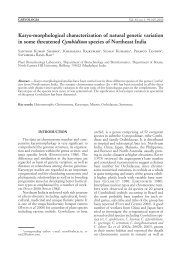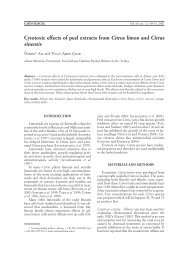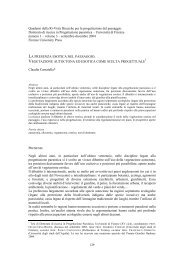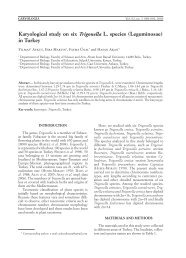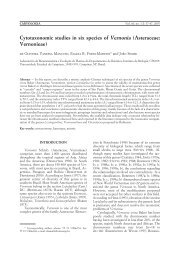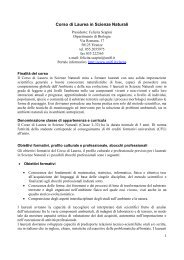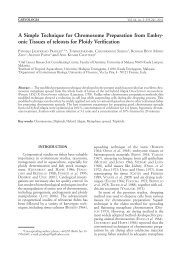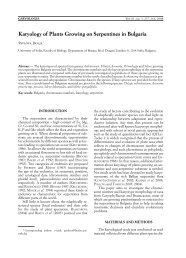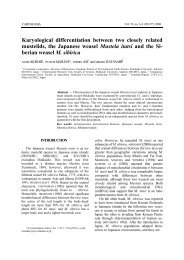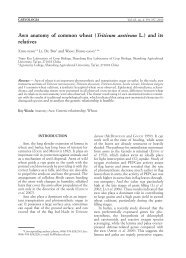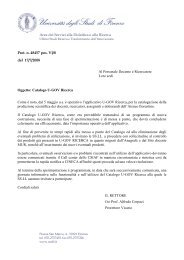A revised cytotaxonomy of the genus Tulbaghia (Alliaceae)
A revised cytotaxonomy of the genus Tulbaghia (Alliaceae)
A revised cytotaxonomy of the genus Tulbaghia (Alliaceae)
You also want an ePaper? Increase the reach of your titles
YUMPU automatically turns print PDFs into web optimized ePapers that Google loves.
86 VOSA<br />
nently coloured. Intermediate types include T.<br />
coddii and T. natalemis where <strong>the</strong> perianth segments<br />
are pigmented but in contrasting colours<br />
with <strong>the</strong> corona. Some species such as T. galpinii<br />
and T. rhodesica represent special cases. T.<br />
galpinii is a tiny species which resembles a diminutive<br />
T. capensis with a deeply cut, but not<br />
very fleshy corona, very thin flaccid leaves and a<br />
different karyotype which places it in <strong>the</strong> T. natalensis<br />
group (Group 5). T. galpinii'is endemic<br />
<strong>of</strong> a very restricted area <strong>of</strong> <strong>the</strong> Eastern Cape and<br />
all cultivated collections seem to be self-fertile.<br />
<strong>Tulbaghia</strong> rhodesica is a tropical species. It<br />
has a karyotype similar to that <strong>of</strong> T. cameroni,<br />
which comes from <strong>the</strong> same region, but, in contrast<br />
with his latter species, has brightly colored<br />
flowers with broad perianth segments and a very<br />
short, deeply lobed corona <strong>of</strong> <strong>the</strong> same colour. It is<br />
difficult to define <strong>the</strong> affinities <strong>of</strong> T. rhodesica<br />
which probably represents a very ancient type<br />
well adapted to tropical light forest conditions.<br />
<strong>Tulbaghia</strong> simmleri may represent an extreme<br />
evolutionary type. It possesses some peculiar<br />
characters such as its flower morphology<br />
with somowhat fleshy perianth segments and <strong>the</strong><br />
comparatively small chromosomes (VosA<br />
1975). Its breeding behaviour in crosses with<br />
o<strong>the</strong>r species is interesting showing ra<strong>the</strong>r scarce<br />
affinity. In fact, although a number <strong>of</strong> seeds in<br />
produced in most reciprocal crosses and <strong>the</strong>se<br />
germinate well, <strong>the</strong> resulting plantlets seem to<br />
have a defective root system and fail to grow<br />
(VOSA 1996c).<br />
Field observations have shown that population<br />
structure, in different species, presents some<br />
interesting features. In optimal conditions, all <strong>the</strong><br />
species with highly coloured or white flower,<br />
such a T. violacea, T. cominsii, T. natalensis and<br />
T. coddii, occur <strong>of</strong>ten in dense populations<br />
especially along water courses or in vleis or, as in<br />
<strong>the</strong> case <strong>of</strong> T. simmleri, in light but somewhat<br />
humid mountain forest. All <strong>the</strong> species with<br />
inconspicuosly coloured flowers such as T.<br />
acutiloba, T. cernua, T. alliacea, T. capensis, etc.<br />
occur mostly in very small clumps or, more <strong>of</strong>ten,<br />
as single plants at quite a distance from one<br />
ano<strong>the</strong>r. This situation may probably reflect a<br />
kind <strong>of</strong> strict interaction between flower colour<br />
and eventual pollinators.<br />
Taxonomic treatment<br />
1. <strong>Tulbaghia</strong> capensis Linnaeus, Mant. 2:148,223<br />
(1771); Jacq. Hort. Vindob. 2: 52, PL 115 (1772)<br />
1773);WIUd.,Sp.P1.2:33(1779);Enum.Hort.Berol.<br />
349 (1809); Baker, J. Linn. Soc. Bot. (London) 11:370<br />
(1871), Fl. Cap. 6: 406 (1897); Uph<strong>of</strong>, Herbertia, 10:<br />
45 (1943); Vosa, Ann. Bot. 34: 66-68 (1975); Burbidge,<br />
Notes R. hot. Gds. Edinb. 36: 84 (1978).<br />
TYPE —411.1 (Linn!).<br />
SYNONYMS — <strong>Tulbaghia</strong> pulchella Ave-Lall. in Bull.<br />
Cl. Phys. Math. Acad. Petersb. 3: 204 (1844), nom.<br />
illegit.<br />
<strong>Tulbaghia</strong> alliacea auct. non L. £, Sims, Curtis's<br />
Bot. Mag. 21: t. 806(1805).<br />
ICONOGRAPHY — Jacquin in PI. Hort. Bot. Vindob. 2:<br />
52, PL 115 (1772-1773); Curtis's Bot. Mag. 21: t.<br />
806, 1805; (VosA 1975, fig. 3, Plate I, fig. 3); Plate<br />
IA.<br />
CHROMOSOME NUMBERS — 2n=2x=12; 2n=4x=24;<br />
2n=6x=36 (karyotype C, group 1, fig. 22b; fig. 1).<br />
DISTRIBUTION — Endemic to <strong>the</strong> South Western<br />
Cape. Diploids and tetraploids are found only in <strong>the</strong><br />
eastern part <strong>of</strong> <strong>the</strong> range.<br />
EXSICCATA — Diploids: CAPE. - 3421 (Riversdale):<br />
1.5 km E <strong>of</strong> Heidelberg, Vosa, 294/14 (OXF).<br />
Figs. 1-21 — Mitotic metaphases in <strong>Tulbaghia</strong>: in all micrographs,<br />
<strong>the</strong> positions <strong>of</strong> <strong>the</strong> nucleolar organizing regions are<br />
indicated by arrows. Fig. 1 — <strong>Tulbaghia</strong> capensis (2x), karyotype<br />
C.




